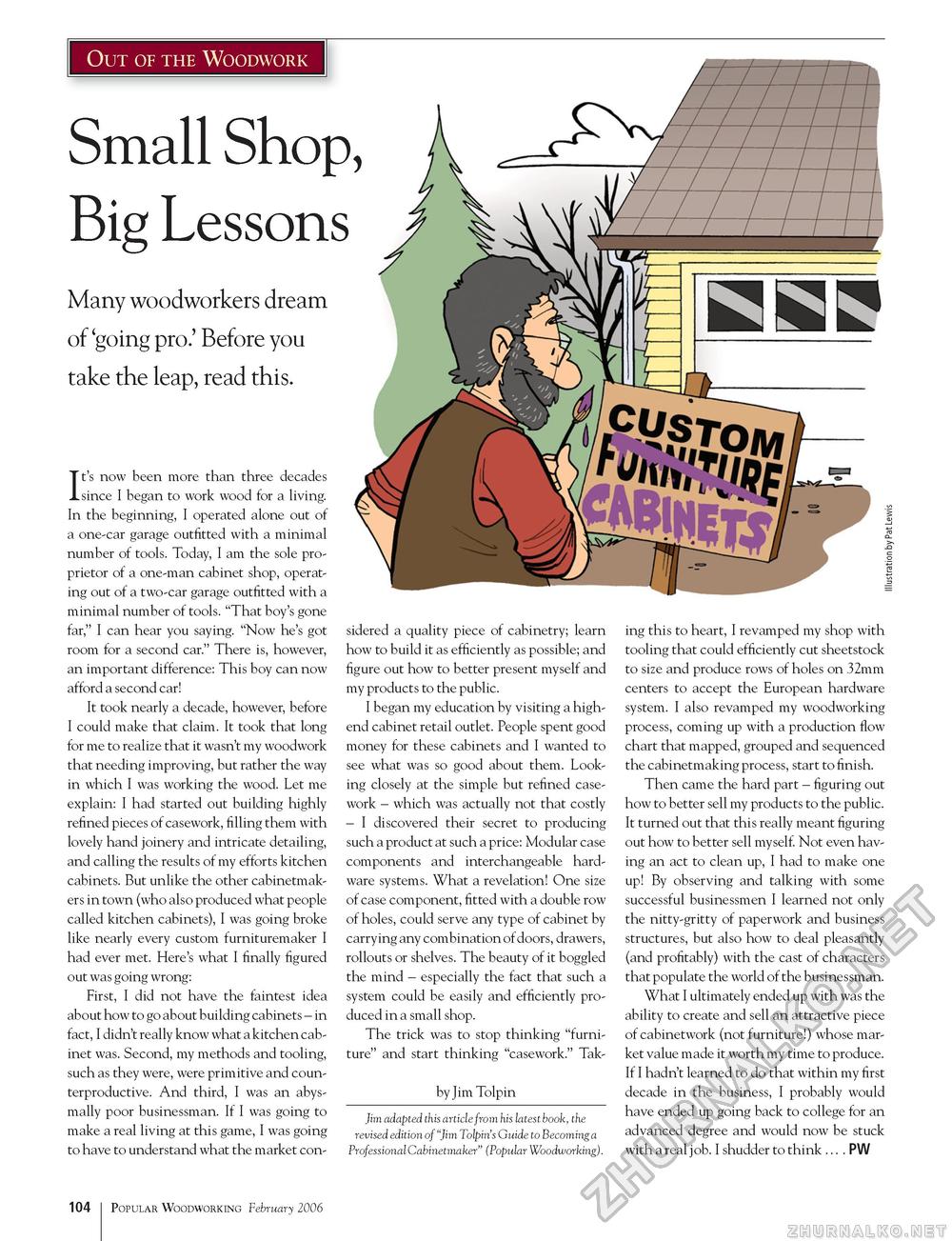Popular Woodworking 2006-02 № 153, страница 103
Out of the Woodwork Small Shop, Big Lessons Many woodworkers dream of 'going pro.' Before you take the leap, read this. It's now been more than three decades since I began to work wood for a living. In the beginning, I operated alone out of a one-car garage outfitted with a minimal number of tools. Today, I am the sole proprietor of a one-man cabinet shop, operating out of a two-car garage outfitted with a minimal number of tools. "That boy's gone far," I can hear you saying. "Now he's got room for a second car." There is, however, an important difference: This boy can now afford a second car! It took nearly a decade, however, before I could make that claim. It took that long for me to realize that it wasn't my woodwork that needing improving, but rather the way in which I was working the wood. Let me explain: I had started out building highly refined pieces of casework, filling them with lovely hand joinery and intricate detailing, and calling the results of my efforts kitchen cabinets. But unlike the other cabinetmakers in town (who also produced what people called kitchen cabinets), I was going broke like nearly every custom furnituremaker I had ever met. Here's what I finally figured out was going wrong: First, I did not have the faintest idea about how to go about building cabinets - in fact, I didn't really know what a kitchen cabinet was. Second, my methods and tooling, such as they were, were primitive and counterproductive. And third, I was an abysmally poor businessman. If I was going to make a real living at this game, I was going to have to understand what the market con sidered a quality piece of cabinetry; learn how to build it as efficiently as possible; and figure out how to better present myself and my products to the public. I began my education by visiting a high-end cabinet retail outlet. People spent good money for these cabinets and I wanted to see what was so good about them. Looking closely at the simple but refined casework - which was actually not that costly - I discovered their secret to producing such a product at such a price: Modular case components and interchangeable hardware systems. What a revelation! One size of case component, fitted with a double row of holes, could serve any type of cabinet by carrying any combination of doors, drawers, rollouts or shelves. The beauty of it boggled the mind - especially the fact that such a system could be easily and efficiently produced in a small shop. The trick was to stop thinking "furniture" and start thinking "casework." Tak- by Jim Tolpin Jim adapted this article from his latest book, the revised edition of"Jim Tolpin's Guide to Becoming a Professional Cabinetmaker" (Popular Woodworking). ing this to heart, I revamped my shop with tooling that could efficiently cut sheetstock to size and produce rows of holes on 32mm centers to accept the European hardware system. I also revamped my woodworking process, coming up with a production flow chart that mapped, grouped and sequenced the cabinetmaking process, start to finish. Then came the hard part - figuring out how to better sell my products to the public. It turned out that this really meant figuring out how to better sell myself. Not even having an act to clean up, I had to make one up! By observing and talking with some successful businessmen I learned not only the nitty-gritty of paperwork and business structures, but also how to deal pleasantly (and profitably) with the cast of characters that populate the world of the businessman. What I ultimately ended up with was the ability to create and sell an attractive piece of cabinetwork (not furniture!) whose market value made it worth my time to produce. If I hadn't learned to do that within my first decade in the business, I probably would have ended up going back to college for an advanced degree and would now be stuck with a real job. I shudder to think ... . PW 104 Popular Woodworking February 2006 |







